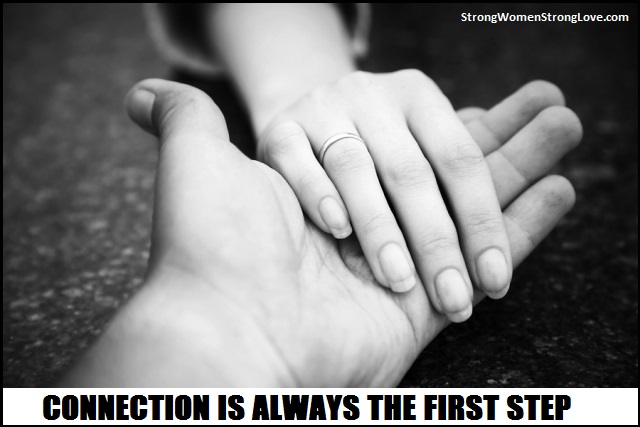by Strong Women Strong Love | Jun 14, 2017 | Books, Passionate Partnership |

Is insecurity or withdrawal — by you, your husband or both of you — an issue in your marriage? Today, I’ll give you some insight into what might be going on. I’ll explore different attachment styles and how they play into your relationships.
Your family is actually the very first place you learn about relationships. The experiences you have with your caregivers have a strong influence over how you relate to other people in your life. Understanding your particular style of connecting helps you see what strengths and vulnerabilities you bring to your marriage.
What Is Your Attachment Style?
If you’re lucky, your early caregivers were loving, responsive, and reliable. If so, you learned that you can trust people and developed a secure attachment style. You’re probably comfortable with emotional intimacy and depending on others, which, as you can imagine, makes it easier to be in a relationship. About 60 percent of people have this attachment style.
But what if your parents or caregivers weren’t so consistent? Maybe they were there for you sometimes, but other times were physically or emotionally unavailable when you needed them. These experiences can lead to an ambivalent/anxious attachment style. It’s characterized by feeling unsure whether someone will actually love you and worried that they may leave. People who are clingy or very sensitive to rejection often have this style.
Children of parents who were regularly unavailable or unresponsive can develop an avoidant attachment style. They learn to take care of themselves at a very young age. This independence can cause them to have trouble seeking emotional closeness with others. A person with this style may seem like an aloof or uncaring partner.
Finally, there’s the disorganized attachment style. It can arise in children who suffer abuse or neglect, or whose parents frighten them because of their own unresolved trauma. These children grow up to become adults who struggle with trusting others, managing their emotions and even feeling safe at all.
In reading the descriptions of the different attachment styles, you probably have a sense now of what your own might be. This quiz can also help you pinpoint your attachment style.
Working With Your Attachment Style
If both you and your husband have a secure attachment style, that’s great news for your marriage. You have a sound foundation for weathering a relationship’s normal ups and downs.
But if one of you doesn’t have a secure attachment style now, that hardly means your marriage is doomed. It’s possible to shift your attachment style. If you happen to have found a secure partner, that may help you to eventually develop a secure connection too.
The most challenging situation is when both of you have insecure attachment styles. It’s common, for example, for ambivalent/anxious and avoidant people to couple up — and drive each other crazy. One will cling, and the other will try to get away. Just understanding where each of you is coming from can be helpful. But you may need to seek counseling to protect your marriage and to develop healthier ways of relating.
If you’re looking for more insights to help you better understand how your attachment style affects your marriage, I highly recommend Attached: The New Science of Adult Attachment and How It Can Help You Find – and Keep – Love by Amir Levine, MD and Rachel Heller, MA.
by Strong Women Strong Love | May 14, 2017 | Passionate Partnership |

There are two times in a marriage when couples are most likely to split. The first comes around the seven-year mark. The second comes at around 12 years. Whether or not you’re near one of those milestones, it’s always good to monitor your relationship health. Here are a few tips to guide you through a marriage checkup.
Managing Conflicts
In the seven-year danger zone, splits happen because of conflicts. Not surprisingly, this time frame is when many couples are starting a family and dealing with all of the associated stresses. The warning sign in this time period isn’t how often you fight. It’s whether you fight the right way.
Specifically, look at whether your conflicts are characterized by Dr. John Gottman‘s “Four Horsemen.” Gottman gave these behaviors such a dramatic name because their constant presence in a marriage strongly predicts which couples will divorce.
The Horsemen are:
- Defensiveness
- Criticism
- Stonewalling
- Contempt
If you don’t like the behaviors you’re bringing to conflicts with your husband, you might need to cut yourself a break and focus on self-care. When we’re stressed (as most of us seem to be constantly), we get more controlling, rigid and judgmental in our relationships with others.
Staying Close
At 12 years, couples tend to split because they’re becoming alienated from each other. Again, our stressed and busy lives play a role. It can be tricky to nurture your relationship amid everything else you’re juggling, but it’s vital.
To keep your bond strong, consider questions like these.
- Is the amount of physical intimacy in your relationship satisfying for both of you? Your physical relationship strengthens your emotional relationship.
- Do you treat each other with the same consideration that you’d treat good friends?
- Do you take advantage of opportunities to show love and appreciation — such as greeting each other warmly after your work days?
- Do you practice deep listening (making eye contact, summarizing what the other said, etc.) with each other?
- Are you curious about each other? In other words, do you ask yourself questions like “He seems tense. I wonder what’s going on with him?” instead of leaping to conclusions?
Whether you’ve been married one year or 50 years, look through this blog for more tips and insights to improve the health of your marriage. Although your relationship may feel fine right now, doing a regular checkup can be an important part of keeping things on track.
by Strong Women Strong Love | Mar 16, 2017 | Passionate Partnership |

You know that look in his eyes or that certain touch. He’s feeling amorous. But you’re just not in the mood for sex. Everyone feels like saying no to sex sometimes. But it’s important to do it in a way that respects your partner’s feelings and that maintains the overall health of your relationship.
Some Myths About Sex and Marriage
It might ease your mind to know that there are some common misperceptions about sex and marriage. The big one is that there’s some “magic number” — the amount of sex you’re supposed to be having. That’s not just true. The number of times you have sex in any week, month or year isn’t important. What is important? That both of you are satisfied with the amount of sex you are having. Frequency of sex varies a lot among happy couples.
We also tend to have a very limited definition of what sexuality can be in a relationship. If you aren’t doing “the deed,” it doesn’t mean that your marriage isn’t sexual. A sexual connection is about more than intercourse. It can also mean holding hands, feeling an emotional bond, making loving contact or sending sexy texts. At times in a marriage where intercourse naturally wanes — such as after the birth of a child — it’s good to have this expanded vocabulary of sexual acts to draw on to keep your bond strong.
Be Honest about the Underlying Cause
Sexuality is an important part of your marriage. If your desire is misaligned with your husband’s, start by looking for possible causes.
There could be a physical reason you’re just not in the mood for sex lately. Health issues, medications, hormonal changes, aging … they can all put a damper on your libido. Consider getting a checkup if you suspect a physical cause for your lack of sexual desire.
Your lack of desire might also have an emotional component. You might be bringing some other issues into the bedroom. If, say, you’re super-resentful that he doesn’t do more around the house, it’s hard to feel too frisky. It’s important to deal directly with the problem that’s dampening your desire.
Or you could just be plain exhausted by the frantic pace of our lives today, so you stop having sex as often. Unfortunately, the less frequently you have sex, the less likely you are to want it (use it or lose it). If your sex life has fizzled out because you’re busy and tired, try scheduling some time to get intimate when you’re not so worn out. This doesn’t sound very romantic, but it actually works.
If You Do Need to Say No to Sex
When you do turn your husband down, communicate what’s going on with you. For example, “I’m exhausted after these past two days at work” or “I just can’t stop thinking about my mom’s illness right now.” He needs to know that he’s not the reason you’re not in the mood for sex. It’s also helpful to suggest another time the two of you can possibly connect sexually.
Taking a pass on sex will feel a lot less charged if your husband isn’t the only one who ever initiates it. If he’s always the one who has to risk rejection, he could just stop asking. Make the first move sometimes.
Consider Saying ‘Yes’
Sometimes you really, really are not in the mood for sex. When it’s just not happening for you, don’t hesitate to say no. But sometimes your mood might be more “eh” than “no.” Or maybe you know that you tend to get more into things once sex gets started. If that’s the case, consider giving him the thumbs-up. But this should not become the pattern in your relationship.
For more advice like this, check out my book Strong Women, Strong Love. I wrote it to help busy couples enhance both physical and emotional intimacy.
by Strong Women Strong Love | Feb 2, 2017 | Passionate Partnership |

With Valentine’s Day near, it’s a good time to talk about the work of The 5 Love Languages by author Dr. Gary Chapman.
Chapman’s book has sold millions of copies, and with good reason. His 5 Love Languages framework is a helpful way of understanding how you and your spouse express and feel love. The idea is that once you know which Love Language each of you speaks, you will be more effective at making each other feel loved.
Let’s take a quick look at each of Chapman’s Love Languages.
1. Words of Affirmation
If this is your Love Language, it’s extra-important to you to hear your partner say that you are loved and appreciated. Really, though, who couldn’t use a few more kind words and compliments? Remembering to express appreciation or to praise each other builds up goodwill in your marriage. Your words of affirmation don’t have to be elaborate or flowery. The important thing is to share them when they come to you. Of course, if this is the Love Language for either of you, be more deliberate about expressing loving compliments or bragging about your spouse to others.
2. Acts of Service
Some people show their love by doing things for the people they care about. Traditional husbands often speak this Love Language, but their message may be missed if their spouse speaks a different Love Language. For instance, your husband may be doing things for you, but you may not feel loved until he compliments you or gives you gifts. Of course, this can go the other way too. You may be the one who is always bending over backward to take care of your husband and end up feeling unloved if he does not help you around the house without being asked.
3. Receiving Gifts
There is a strong emphasis on giving gifts in our society, and days like Valentine’s Day often place tremendous pressure on husbands to find the right gift. If this is your Love Language and you have your hopes set on a particular gift, be sure to speak up. It’s much more effective to be direct with your husband about what you want instead of dropping hints or assuming he should “just know” what you like. Remember, he wants to make you happy, so he’s not likely to get his feelings hurt if you point him toward the gifts that make you feel treasured. Your directness will spare you unnecessary disappointment.
4. Quality Time
So how are you supposed to speak this Love Language when both of you are crazy-busy? One way is by offering undivided attention when you can. Even something as simple as acknowledging each other with a warm hello when you get home goes a long way. That being said, if this is the primary Love Language for either one of you, you must make spending regular quality time together a high priority.
5. Physical Touch
Humans need loving touch. It helps us feel safe with each other. Some people need more touch than others, so if that’s the case with you or your spouse, look for ways to be physically expressive with your love. Perhaps add a kiss and a hug to that post-work greeting or hold hands when you’re sitting on the couch. Remember, though, that touch isn’t always synonymous with sex. It’s not uncommon for parents to go through sex droughts because of a lack of time or privacy, but expressing physical affection can keep the fires burning till you can get back in the groove.
Talking with your husband about your respective Love Languages can open up new intimacy in your marriage. Take an online quiz and discover which Love Languages the two of you speak! Apply what you learn, and see how it draws the two of you closer.
by Strong Women Strong Love | Nov 1, 2016 | Passionate Partnership, Persistent Pressures |

I’m a big fan of psychiatrist Daniel Siegel. You may remember a past blog post where I shared some of Siegel’s advice about what to do when you “flip your lid.”
Today, I want to talk about another strategy from Siegel. You may have heard of his Connect and Redirect method in the context of parenting. But the ideas behind it can strengthen your marriage (or any other relationship, for that matter).
The key thing to remember about Connect and Redirect is that any interaction will be more fruitful and satisfying if you take a moment to establish emotional connection before launching into what you need.
In our marriages, though, we often forget this step. Because we’re all so busy, it seems easier just to “cut to the chase.” We also tend to take those we’re closest to for granted and be much more abrupt and less tactful with them than we are with other people.
But taking that extra moment to build connection pays off. It helps your spouse get into the mental space where he can truly hear what you’re saying and engage with you.
Make Connection a Habit
Establishing connection doesn’t take long and it’s not complicated. Loving touch and positive eye contact go a long way. So does acknowledging what’s going on with your husband before you bring up the topic you want to discuss. You don’t have to reserve this communication technique for big, important discussions. It’s just as handy when you’re dealing with the routine concerns of family life.
Compare these two interactions:
- Your husband arrives home clearly still stressed from work or his commute. You shout from the kitchen, “The cable’s out again – what are we going to do about this?”
- Your husband arrives home looking stressed. You greet him with a quick hug and kiss and ask what’s up. He says traffic was much heavier than usual during his drive home. “Ugh! Frustrating!” you commiserate. “When you’ve had a chance to unwind a little, I want to talk to you about maybe changing cable providers.”
In the second interaction, you’re letting your husband know that he’s cared for and that he doesn’t have to put his defenses up. You’re making it easier for the two of you to work together for a solution to the cable issue.
As I said earlier, sometimes we have to be deliberate in giving our spouses the same consideration we automatically show our friends. If you know this area is a trouble spot for you, you may want to remind yourself to frame things with your husband the same way you would if you were talking with a friend. If, for example, you needed to reschedule your weekend trip with a friend, you’d probably take a minute to check in on her life and see if it’s a good time to talk before you told her about the change in plans. But you might be tempted to skip those “niceties” with your husband.
Remember, though, that we all need reminders that the people we care about care about us in return. When we get them, we show up more fully and give more generously. The time you invest in nurturing that feeling of connection is well worth it.
by Strong Women Strong Love | Sep 1, 2016 | Passionate Partnership, Personal Power, Quotes |

Sometimes, I hear from angry readers who don’t believe I’m supporting women being strong. Their words have a common theme:
Why should I do my part to make the marriage better when my husband isn’t doing his? Why are you telling me to be respectful and patient when he doesn’t deserve it? Why should I appreciate him when he doesn’t appreciate me?
I get the feeling these readers think I am urging them to be a doormat. But that’s not the case. After all, the name of this blog, and my book, is Strong Women, Strong Love.
The kind of strength I am talking about is broader than the type most revered in our culture.
In the U.S., we tend to celebrate those who are fiercely independent, firm and unstoppable — who take a stand and won’t ever back down. That’s what we usually think of as real strength.
But there’s another kind of strength, too. One that’s more valued in the East. Think about the willow tree and how it stands strong in the storm because of its tremendous flexibility. Or, the power of water, even as it follows every bend and curve of the river bank.
Both kinds of strength, being determined and being flexible, have value. We do face circumstances that require us to stand firm. But we also face times when we’d be better served by calling on our openness and adaptability.
Keep being a strong woman, but consider expanding your definition of what it means to be strong.
If you can call on both kinds of strength — being firm and being flexible — you’ll be better able to cope with the ups and downs of both your relationship and life as a whole.







